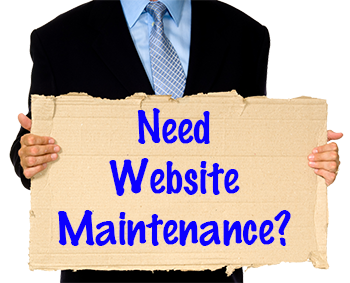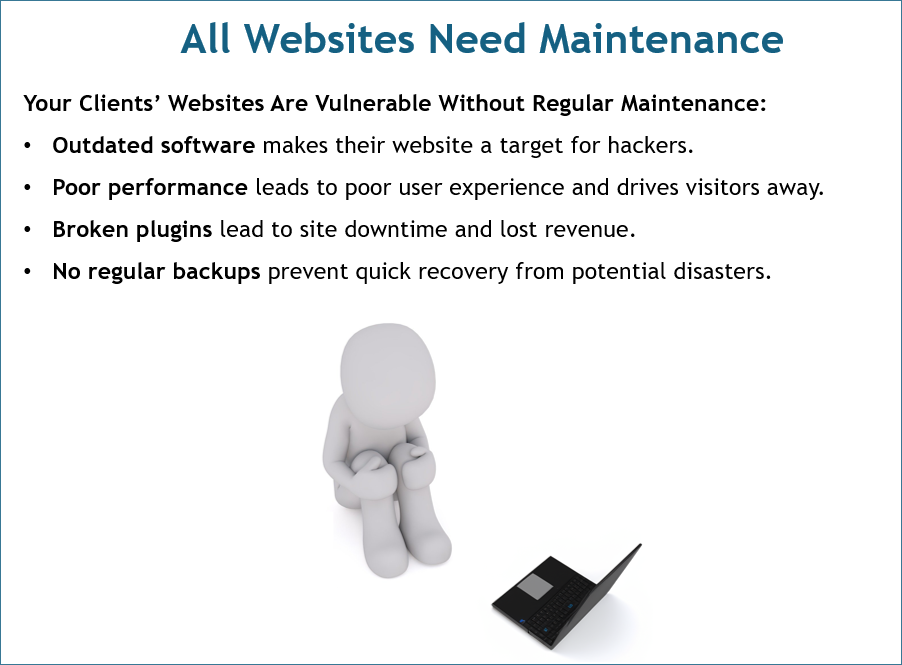
Skyrocket Your WordPress Maintenance Sales With This MRR-Boosting Strategy 🚀
Ready to supercharge your WordPress maintenance sales? Buckle up! We’re diving into a powerful, low-cost strategy that will win you more clients and boost your recurring revenue like never before.
As a web developer or digital agency specializing in maintenance services, mastering a strategic sales approach is your golden ticket.
This comprehensive guide is packed with practical insights to enhance your prospect-to-client conversion rates and pave the way for consistent and growing Monthly Recurring Revenue (MRR).
Let’s break down the game plan:
- Understand the Challenges of Selling Maintenance Services
- Use A Strategic Approach to Outsell Your Competition and Win More Clients
- Develop an Effective Sales Strategy For Your Business Using a Proven Model
- Implement Effective Tools to Communicate Value to Potential Clients
We suggest reading the whole article first for the step-by-step approach, then bookmarking this page and using the links below to review and apply the information.
1. Understand The Challenges of Selling Website Maintenance Services
First things first: selling maintenance services comes with its own hurdles. These challenges generally fall into two camps:
- Your Competition
- Your Clients
The Challenge of Outselling Your Competition

Is this how you plan to stand out from the competition?
How do you rise above the noise?
About two decades ago, WordPress revolutionized website creation. With its free download, easy installation, customizable plugins, and web design-ready themes, everyone jumped on the bandwagon and launched their own website-building businesses.
Now, web developers and agencies are battling for attention in a crowded marketplace.
To stand out, you need to embrace innovative strategies. It’s not enough to be just another service provider; you have to be the go-to expert in maintenance services.
Let’s face it—your competition is no longer the web developer or marketing agency down the road or across the street. They’re everywhere, and they’re marketing themselves aggressively 24/7, all over the web.
However positioned in the web development services market, you’re sure to be up against tough competition.

A sign that finding new website services clients is getting tougher!
The Challenge of Selling Maintenance Services to Clients
When clients think about web development, maintenance often takes a backseat. Many businesses don’t realize the importance of regular upkeep and the risks of neglecting it. This lack of awareness makes it tough to justify the cost.
Moreover, the technical jargon around maintenance can intimidate potential clients, leaving them hesitant to commit. They might struggle to see the long-term value compared to upfront costs.
But here’s the kicker: you know maintenance is crucial—just like regular vehicle servicing. If businesses ignore their website maintenance, they will inevitably face costly issues down the road.

You know this, but do your potential clients?
Communicating Value
So, how do you communicate this essential message to your clients?
- Educate Them on the Necessity: Make it clear why regular maintenance is vital for their website’s health.
- Highlight Your Expertise: Showcase the unique value your services bring to the table.
- Build Trust: Make a compelling case for why your maintenance services are the best choice for keeping their websites updated, protected, and optimized.
With this framework in mind, let’s strategize to overcome these challenges and elevate your sales game.
2. Use A Strategic Approach to Outsell Your Competition and Win More Clients
“It might sound like an exaggeration, but I went from a 0% success rate on closing care plans to a 100% success rate basically overnight … All I did was I simply stopped presenting this as optional … I just put it as a standard part of my process and pricing.”
Corey Dodd, Web designer
3. Develop An Effective Sales Strategy For your Business Using a Proven Model
Here’s how to ramp up your client base and supercharge your sales of maintenance services using a strategic approach that works like a charm:
- Start with a Proven Sales Model
- Understand Each Sales Phase
- Establish Measurable Benchmarks
- Document Your Sales Processes
- Implement the Model
We’ll tailor this approach specifically for selling WordPress maintenance services and make some easy tweaks that can lead to significant results.
A Proven Sales Model
Study the simple diagram below:

We’ll use this sales process as a blueprint to build a smooth, logical flow, guiding your clients from interest to commitment.
Think of each phase as a finely tuned process that leads to a seamless experience.
Let’s break down each phase, set key benchmarks, and the processes you’ll need to document.
Lead Generation
The first step? Identifying and attracting clients who need WordPress maintenance services.
Key Benchmarks
- Website Visits: Track how many potential clients land on your site.
- Click-Through Rates (CTR): Measure engagement with your content.
- Conversion Rates: Determine how many leads become paying clients.
- Cost per Lead (CPL): Keep an eye on what it costs to generate each lead.
Here’s a checklist to enhance your lead-generation efforts:
1. Build a Strong Online Presence
- Optimize your website to clearly showcase your maintenance services.
- Highlight testimonials and case studies that showcase your impact on security, performance, and updates.
- Focus your on-site SEO on keywords like “website maintenance” and “WordPress support.”
2. Use Referrals
- Tap into the power of word-of-mouth marketing by encouraging satisfied clients to refer you.
- Offer referral bonuses or discounts to motivate clients to spread the word.
3. Use Lead Generation Tools
- Leverage social media ads, SEO, and content marketing to attract leads.
4. Embrace Content Marketing
- Write blog posts, guides, and whitepapers about the importance of website maintenance.
- Educate potential clients on why regular updates, backups, and security checks are essential for smooth operations.
5. Network at Industry Events
- Attend virtual and local networking events to build connections.
- Bring promotional materials that emphasize the value of ongoing website maintenance.
6. Cold Outreach with Value Proposals
- Identify businesses with outdated or slow websites and send personalized proposals on how your services can enhance their performance and security.
- Focus on specific benefits tailored to their needs.
7. Offer Free Audits
- Provide potential clients a free website audit to identify issues like slow load times or security vulnerabilities.
- Use this to pitch your maintenance services by demonstrating how to avoid future problems.
8. Leverage Existing Clients for Upsells
- Offer maintenance packages to your existing web design clients—they already trust you!
- Create tiered packages (e.g., basic, premium) to cater to diverse client needs.
9. Document Your Processes
- Document your processes for running campaigns, tracking leads, and nurturing them through emails and follow-ups.
- Clear documentation ensures everyone on your team is aligned and can deliver a consistent experience.
In upcoming articles and tutorials, we’ll explore various lead-generation strategies, tools, and effective methods to win clients for your maintenance services.
Setting Client Appointments
Once you’ve generated leads, it’s time to take the next big step: scheduling meetings or discovery calls with potential clients.
But remember, until these leads are qualified, they’re just suspects—not prospects!
This phase is all about securing appointments to understand their needs better and qualify them as serious contenders for your services.
Measuring Effectiveness
To ensure this phase is effective, keep an eye on these key benchmarks:
- Number of Appointments Set: Track how many meetings you’re booking.
- Conversion Rate from Lead to Appointment: Measure how many leads turn into appointments.
- Appointment-to-Sale Ratio: See how many appointments result in actual sales.
Here are some practical tips for designing an effective appointment-setting system:
Attracting and Qualifying Leads
- Online Forms and Live Chat: Set up these tools on your website to prompt potential clients to schedule a consultation. Capture essential information like business size and service needs. This will help you filter out unqualified leads to focus on high-potential clients.
- Standardized Scripts: Create appointment-setting scripts and qualifying criteria to streamline your process.
Automated Scheduling Tools
- Simplify Booking: Use automated scheduling tools that allow clients and prospects to find and book consultations easily. This minimizes back-and-forth communication and boosts appointment rates.
- Automatic Reminders: Implement reminders to reduce no-shows and keep clients informed.
Lead Nurturing and Qualification
- Integrate with a CRM: Link your appointment system to a lead management tool to pre-qualify leads based on interest or behavior. This ensures you book appointments with high-quality prospects who are likely to convert.
- Automated Follow-Up: Use follow-up sequences to nurture leads before meetings, building trust and keeping your services top of mind.
Personalized Communication
- Tailor the Discussion: Gather relevant details during bookings, such as your prospect’s website needs or business goals. This helps you focus on their pain points, increasing the likelihood of converting meetings into sales.
Post-Appointment Follow-Up
- After each appointment, promptly follow up with automated emails reminding prospects of your services and providing additional resources. This keeps them engaged, even if they aren’t ready to commit right away.
Understanding Your Client’s Needs
A formal needs analysis process is essential for:
- Qualifying Prospects: Determine if they are a good fit for your business.
- Understanding Their Needs: Understand their expectations, pain points, budget, and resources.
- Identifying Gaps: Spot any shortcomings in their current site management.
- Tailoring Solutions: Align your offerings with their specific needs and budget to increase your chances of winning the business.
Key Benchmarks for Needs Analysis
- Utilize tools like questionnaires, interviews, and discovery calls to gather information about challenges and goals.
- Track the number of needs assessments conducted and conversion rates from analysis to solution presentations.
Developing an effective needs analysis system involves the following procr
Initial Discovery
Conduct thorough discovery sessions to pinpoint the prospect’s critical needs, business goals, pain points, and current website state.
This ensures you understand precisely what they require—whether that’s security updates or site speed optimization—allowing you to suggest the most relevant maintenance services.
Budget Assessment
Assessing the prospect’s budget is crucial for aligning your service packages with their financial capacity.
For instance, a small business may only need essential updates, while a larger enterprise might require comprehensive security, backup, and optimization services.
Tiered maintenance plans (basic, advanced, premium) allow you to recommend affordable packages tailored to their budget while delivering essential services like plugin updates and security audits.
Resources and Technical Assessment
Whether your prospect has a website or not, a structured needs analysis can be invaluable:
- If they have an existing site, evaluate its infrastructure (hosting, CMS, plugins) to ensure proposed solutions are feasible.
- For those without a website, understanding their technical skills and resources will help you position your services effectively.
By implementing the above, you’ll set appointments with the right clients and enhance your ability to understand and meet their needs.
Matching Your Solution to Your Client’s Needs
Welcome to the critical phase of your sales process: the Solution Presentation.
This is your moment to shine—whether you’re face-to-face, on a virtual call, or sending an email proposal, it’s time to showcase the real value of your maintenance services and demonstrate how your ongoing care can meet their specific needs, ensuring their site is secure, fast, and performing at its peak—all while staying within their budget!
Key Benchmarks
To gauge your success in this phase, monitor key benchmarks such as prospect engagement rates and proposal acceptance rates.
A Structured Approach
To ensure your client truly understands the value and relevance of your services, implement standardized processes for:
-
Presentation Methods: Decide on your approach—face-to-face meetings, virtual calls, email proposals, demo sessions, or presentation scripts.
-
Customized Proposals: Tailor your proposals to highlight the benefits of your maintenance services, including improved security, performance enhancements, ongoing support, costs, payment methods, terms of service, timelines, and responsibilities.
Critical Elements for An Effective Solution Presentation
1. Personalized Proposal Creation
Craft proposals that specifically address your client’s pain points. Use insights gathered from your needs assessment—whether it’s concerns about site speed or security vulnerabilities.
For example, if security is a concern, include ongoing monitoring in your plan. If they’re launching an e-commerce site, your proposal should detail custom development and monthly maintenance for plugin updates, SEO optimization, and backups to ensure a smooth shopping experience.
2. Demonstrate Value with Case Studies
Showcase real-world examples of clients who’ve benefited from your combined development and maintenance services. Highlight tangible improvements like reduced downtime, faster load speeds, and increased traffic achieved through regular updates and optimizations.
3. Visual Demonstrations
Use visual aids such as mockups and demos to help clients envision how your proposed solution will look and function. This aligns with their business goals and illustrates how your services will enhance their site’s performance—think faster load times and improved SEO rankings.
4. Highlight Long-term Value
Make sure to emphasize the long-term benefits of your WordPress maintenance services, such as reduced downtime, enhanced user experience, and sustained performance.
Stress that regular updates, backups, and monitoring are essential for protecting their website from threats and ensuring its continued functionality.
5. Package Bundling
Present bundled packages that combine website development with various levels of maintenance services—basic, advanced, and premium.
Clearly state your recommendations and allow clients to choose a package that best suits their budget and needs.
6. Offer Scalable Maintenance Packages
Include maintenance options that can scale with the client’s business. Start with a basic package, but allow for the addition of advanced services like 24/7 monitoring or detailed reporting as needed.
For example, a retail business launching a new site may require extra services to manage seasonal traffic spikes and ensure robust security.
7. Expectation Management
Set clear expectations regarding your maintenance services to help clients understand the project scope and expected outcomes. In your presentation, outline deliverables, timelines, and communication protocols. Incorporate scheduling regular check-ins and delivering performance reports to demonstrate ongoing value and boost client satisfaction.
8. Presentation Scripts
Develop and refine scripts for your presentations. These should clearly communicate your value propositions, address common objections, and offer support through case studies, testimonials, and FAQs.
Use incentives to ease hesitations and close the sale effectively. Continuously improve your scripts to enhance sales presentations and increase closing success rates.
By following these strategies, you’ll match your solutions to your clients’ needs and build a compelling case for the value of your maintenance services, ultimately leading to more successful conversions!
Client Decision
We’ve come to the pivotal Client Decision phase! This is where your hard work pays off.
If you’ve done your job right, your presentation will perfectly align with their needs, providing them with all the information necessary to make an informed choice.
If They Say “Yes”
Fantastic! It’s time to sign them up for your maintenance contract or web care plan. Celebrate this win! ✋
If They Say “No” or “Not Yet”
Don’t worry; this isn’t the end of the road. You can employ several strategies to address their hesitations and move the conversation forward.
We’ll explore these further below.
Post-Sales: Client Onboarding and Building Relationships
An effective post-sales system is crucial for onboarding clients and cultivating lasting relationships. This demonstrates your commitment to their success and helps build trust and loyalty.
Key Benchmarks
Track these metrics to gauge your effectiveness:
- Client Satisfaction Post-Onboarding: Are they happy with the initial process?
- Time to Onboard New Clients: How quickly can you get them up and running?
- Successful Handoffs: Is the transition smooth from sales to service?
- Consistency in Service Delivery: Are your communications and services reliable?
- Measuring Client Retention Rates: Are your clients sticking around?
- Upsell Opportunities: How often are you able to introduce additional services?
Essential Processes for This Phase
1. Onboarding and Setup Support
- Checklists and Welcome Emails: Create onboarding checklists and personalized welcome emails to guide new clients.
- Documentation: Outline procedures for accessing setup, introducing ongoing communication tools, and providing customer support for communications, issue notifications, and invoicing.
- Education: Ensure clients understand the benefits and functionality of their website and maintenance services. Provide training on regular updates, security patches, and performance optimizations to keep their site running smoothly.
Immediately after closing a sale, offer onboarding support to help clients feel comfortable navigating their new website.
2. Regular Communication
Keep the lines of communication open. Schedule regular follow-ups, share performance reports, and provide proactive updates on the health of their website.
Inform clients about new security risks, potential upgrades, and other critical issues that could affect their site.
3. Proactive Maintenance, Monitoring & Reporting
Prevent issues before they arise! Automate maintenance tasks wherever possible to save time and deliver cost-effective services. Establish a client success team focused on proactive improvements and relationship management.
4. Client Feedback and Customization
Implement periodic check-ins and maintenance reports to engage clients consistently. Regularly gather feedback to adjust your services according to their evolving needs.
5. Tailored Upselling Opportunities
Based on what you learn from your clients, suggest additional services like enhanced security, SEO, or custom development. Regularly provide value-added offers that align with their business goals.
Focusing on these areas will facilitate a smoother client decision-making process and lay the foundations for building a strong, ongoing relationship that encourages loyalty and satisfaction. Your clients will feel valued and understood, and this will help to set the stage for long-term success
4. The Secret to Selling More Website Maintenance Services: The Right Tools at Every Stage 🧰
Imagine this: every touchpoint with your client is seamless, every proposal answers their unspoken questions, and every follow-up solidifies trust.
This isn’t just good luck; it’s the result of having a carefully crafted sales strategy to guide prospects through each step of the sales process.
When you use the right tools to sell website maintenance services, you’re not just making sales – you’re creating lasting partnerships that deliver monthly recurring revenue (MRR).
Using the right tools will help drive more conversions and build stronger client relationships.
How Using The Right Tools Boosts Conversions and MRR 📈
1. Attract More Leads
It all starts with lead generation. With optimized, high-value content crafted specifically to resonate with prospects, you’ll draw in more leads who are genuinely interested in long-term site maintenance.
You’ll want blog content, social media templates, and lead magnets that speak directly to potential clients’ pain points – speed, security, updates, and more.
The result? Qualified leads who already see the value in regular maintenance.
2. Close More Deals with High-Converting Sales Content
Once you have their attention, use proposal templates, pricing calculators, and case studies to clearly demonstrate the ROI of website maintenance.
At this stage, your content shouldn’t be informative but persuasive and aimed at helping clients understand the risks of not maintaining their sites and the long-term gains they’ll see with a reliable maintenance partner (you!).
3. Build Long-Lasting Relationships
Selling maintenance services isn’t about a one-time transaction – it’s about building trust. You’ll want onboarding materials, email follow-ups, and monthly report templates to keep clients informed and invested in their site’s performance.
By staying engaged and showing consistent value, you’ll transform your clients into long-term partners who rely on you to keep their sites running smoothly. This ongoing relationship means monthly revenue you can count on.
4. Boost Monthly Recurring Revenue (MRR)
Every recurring maintenance contract adds to your MRR, providing reliable income that fuels growth.
Here, you’ll want tools that allow you to scale this process efficiently, making it easy to upsell existing clients on added services (e.g., speed optimization, security audits) and ensuring that every new client sees the benefits of consistent maintenance from day one.
The Ultimate WordPress Maintenance Services Sales Toolkit: Your Key to Success
We’ve created a powerful, all-in-one sales toolkit specifically for developers and digital agencies who want to say goodbye to low conversions and working on one-time projects only, and hello to reliable, recurring revenue with maintenance services that will fuel their growth.
Our toolkit includes (among many other things):
- Lead Gen Content: Content strategy blueprint, Marketing swipes, and lead magnets to attract the right clients
- Sales-Ready Proposals: High-converting templates and pricing calculators to help close deals faster
- Client Onboarding Resources: Professional emails and scripts to get clients started smoothly
- Retention & Upsell Tools: Follow-up emails, templates, and email courses with upgrade recommendations to keep clients engaged
This isn’t just another set of templates. It’s a complete sales and marketing toolkit designed to help you sell more maintenance services, retain clients longer, and generate more recurring revenue without extra effort.

The right tools really do make all the difference!
👉 To learn how our toolkit can help to improve your results following the strategy discussed above, go here: Supercharge Your WordPress Maintenance Sales With The Ultimate WordPress Sales Kit
"This is one of the most value packed offers I’ve ever seen! I’ve gotten more out of this than tools I’ve paid 10x for. Support is also extremely helpful and responsive too, so it’s like you get get a long term marketing support partner included in the deal!" - Jean, Agency Owner, JMPLaunch
“Before starting with this tool, I was getting maybe 10% of my design and hosting clients to sign up for maintenance packages. In the last 30 days, 60% of my new clients, and 40% of existing clients have added my maintenance plans! That is higher numbers than I have ever had!" - Wolf Bishop, CEO, Host Magi Inc
"All I can say is WOW! This is one of the most value packed offers I’ve ever seen. I’ve gotten more out of this than tools I’ve paid 10x for!" - Jean, Agency Owner, JMPLaunch
"“After around a month with the product, all I can say is WOW! This is one of the most value packed offers I’ve ever seen. It’s actually insane how much I got. If I didn’t see it myself I’d find it genuinely hard to believe. You could start an entire e-learning platform with this amount of content!" - Jean, Agency Owner, JMPLaunch
"All I can say is WOW! This is one of the most value packed offers I’ve ever seen. It’s actually insane how much I got. If anyone is still on the fence, especially if you’re just starting up, just do it, you won’t regret it!" - Jean, Agency Owner, JMPLaunch
“Before starting with this tool, I was getting maybe 10% of my design and hosting clients to sign up for maintenance packages. In the last 30 days, 60% of my new clients, and 40% of existing clients have added my maintenance plans! That is higher numbers than I have ever had!" - Wolf Bishop, CEO, Host Magi Inc
"This is one of the most value packed offers I’ve ever seen. It’s actually insane how much I got. And it’s useful, up to date stuff too, not just filled with fluff. It’s extremely comprehensive but very well organized, so I was able to immediately integrate his ideas and workflows into my daily processes and the value add for my clients has been huge. I’ve gotten more out of this than tools I’ve paid 10x for!" - Jean, Agency Owner, JMPLaunch
"I would recommend this product to ANY agency, web host, freelancer, designer, or developer looking to add another source of income, or even just looking for ways to better serve your customers!" - Wolf Bishop, CEO, Host Magi Inc



